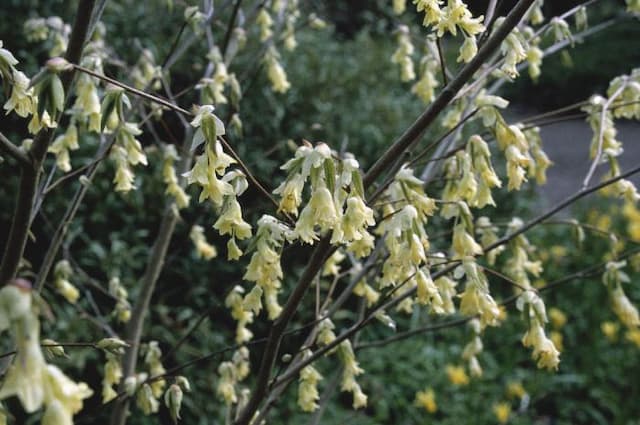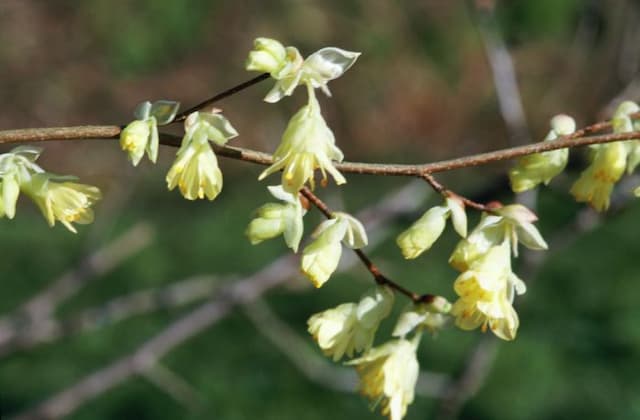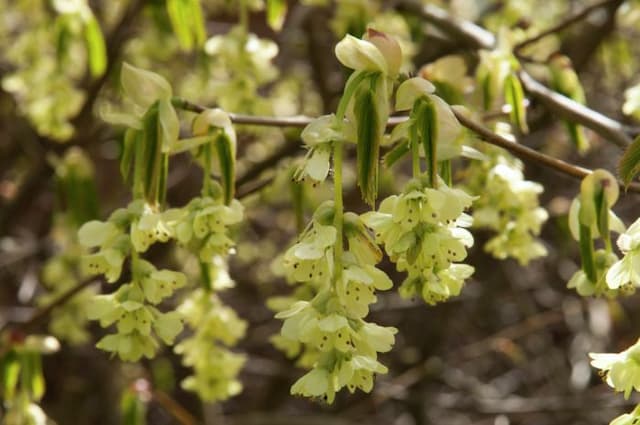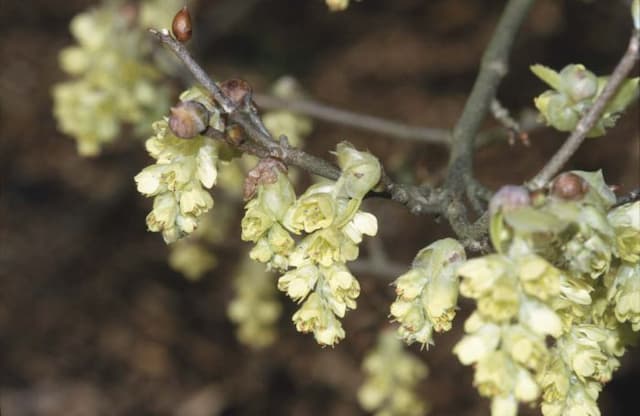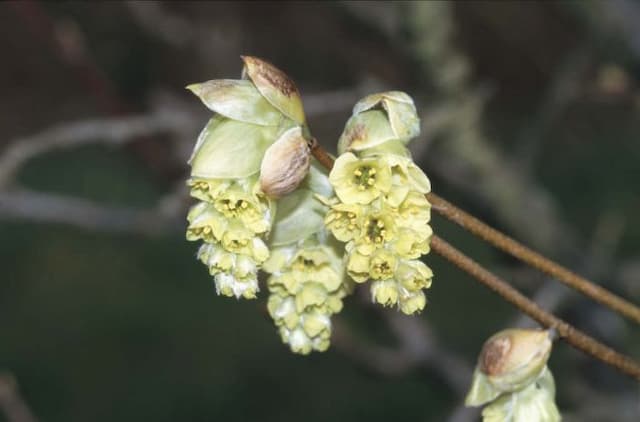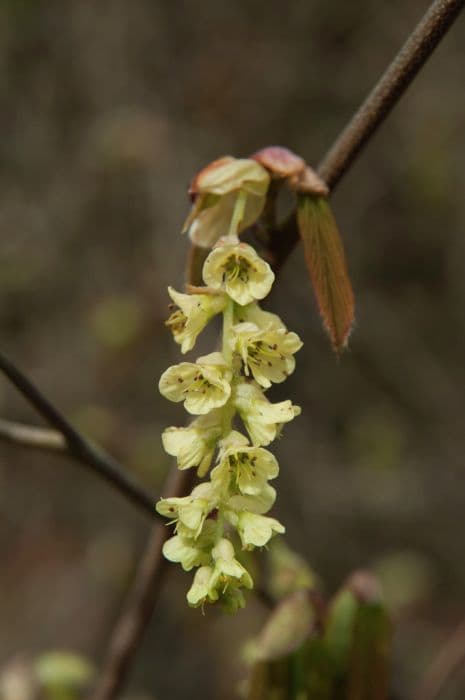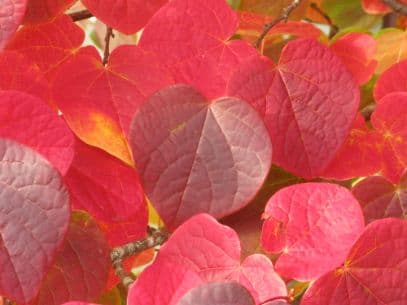Witch Hazel Hamamelis × intermedia 'Glowing Embers'

ABOUT
The Hamamelis × intermedia 'Glowing Embers', commonly known as Witch Hazel, is a visually stunning plant prized for its vibrant and attractive features. This particular cultivar presents a striking display with its large, broad leaves that often exhibit a bold palette of colors, ranging from green in the summer to fiery oranges, reds, and yellows in the fall, reminiscent of glowing embers. The texture of the leaves is somewhat crinkled and they have a distinctive wavy edge. Flowering in the late winter to early spring, 'Glowing Embers' Witch Hazel produces unique, spidery flowers. These blooms come in a tapestry of warm colors, possibly including yellows, oranges, and reds, and are known for their delicate, ribbon-like petals that elegantly unfurl from tight clusters. Providing a striking contrast against the bleakness of winter, these fragrant flowers add a welcome splash of color when few other plants are in bloom. The plant exhibits an open, spreading habit with a natural, graceful silhouette. The branching structure becomes more apparent in the winter after the leaves have dropped, providing visual interest with its somewhat zigzagged, woody framework. This year-round appeal makes 'Glowing Embers' Witch Hazel a cherished choice for gardens that strive for continual seasonal interest.
About this plant
 Names
NamesFamily
Hamamelidaceae
Synonyms
Witch Hazel, Hybrid Witch Hazel, Winterbloom
Common names
Hamamelis × intermedia 'Glowing Embers'
 Toxicity
ToxicityTo humans
Witch Hazel 'Glowing Embers' is generally considered non-toxic to humans. There are no well-documented cases of poisoning from ingesting this plant. However, as with any plant, individual sensitivities can vary, and consuming plant material may potentially cause mild stomach upset or an allergic reaction in some individuals.
To pets
Witch Hazel 'Glowing Embers' is also generally considered non-toxic to pets. It is not known to contain any toxic principles that would pose a risk if pets ingest parts of the plant. As with humans, individual animals may have different sensitivities, and ingestion may cause mild gastrointestinal upset in some pets.
 Characteristics
CharacteristicsLife cycle
Perennials
Foliage type
Deciduous
Color of leaves
Green
Flower color
Yellow
Height
12-15 feet (3.7-4.6 meters)
Spread
10-12 feet (3-3.7 meters)
Plant type
Shrub
Hardiness zones
5-8
Native area
Asia
Benefits
 General Benefits
General Benefits- Year-round interest - With its attractive flowers, foliage, and fall color, the Witch Hazel 'Glowing Embers' offers visual interest throughout all seasons.
- Winter blooms - Produces fragrant yellow flowers in the winter when few other plants are in bloom, adding color to an otherwise dreary landscape.
- Drought tolerance - Once established, it is somewhat drought-tolerant, making it suitable for gardens with occasional water shortages.
- Attracts wildlife - The flowers provide nectar for pollinators such as bees when little else is available, offering ecological support during the cold months.
- Low maintenance - Requires minimal care once established, making it a good choice for gardeners of all experience levels.
- Pest and disease resistance - Generally resistant to many pests and diseases, which reduces the need for chemical treatments.
- Seasonal foliage - Leaves turn attractive shades of yellow, orange, and red in the fall, adding to the plant’s ornamental value.
- Adaptable to various soil types - Can grow in a range of soil conditions, making it versatile for planting in different garden locations.
- Erosion control - Its root system can help stabilize soil and prevent erosion on slopes or in areas prone to runoff.
 Medical Properties
Medical PropertiesThis plant is not used for medical purposes.
 Air-purifying Qualities
Air-purifying QualitiesThis plant is not specifically known for air purifying qualities.
 Other Uses
Other Uses- Photography Subject: With its striking colors, Witch Hazel 'Glowing Embers' is an excellent subject for garden photographers, particularly when capturing the beauty of autumnal gardens.
- Natural Dyes: The vibrant leaves of Witch Hazel 'Glowing Embers' can be used in the process of natural dyeing to impart color to fabrics and yarns.
- Garden Sculpture Accents: During winter, when the leaves have fallen, the unique twisted branches of Witch Hazel make for intriguing natural sculptures in the garden, lending it an artistic touch.
- Sunscreen Alternative: In some cultures, the tannins found in Witch Hazel are utilized as a rudimentary sunscreen, by applying the extract onto the skin, although this is not a replacement for modern sun protection methods.
- Drawstring Bags: Dried Witch Hazel leaves and twigs can be filled into small pouches to create aromatic drawstring bags that can freshen up wardrobes and drawers.
- Landscaping Focal Points: Witch Hazel 'Glowing Embers' can serve as a stunning focal point in landscaping, offering year-round interest with its changing foliage and fragrant winter flowers.
- Culinary Garnish: While not commonly known for its culinary uses, the yellow flowers of Witch Hazel can be used as an edible garnish for salads and desserts, adding a splash of color.
- Perfumery: The petals of Witch Hazel 'Glowing Embers' can be infused in oils to capture their fragrance, which, while not traditional, can be used in homemade perfumes or scented candles.
- Feng Shui Gardens: Witch Hazel can be incorporated into Feng Shui gardens for its dynamic form and colorful display, which are believed to enhance positive energy in the surrounding environment.
- Fall Festivity Decorations: Branches and leaves of Witch Hazel can be used in fall decorations, either on their own or as part of larger arrangements, to celebrate the autumn season.
Interesting Facts
 Feng Shui
Feng ShuiWitch Hazel is not used in Feng Shui practice.
 Zodiac Sign Compitability
Zodiac Sign CompitabilityWitch Hazel is not used in astrology practice.
 Plant Symbolism
Plant Symbolism- Resilience: The Witch Hazel plant, to which 'Glowing Embers' belongs, is known for its ability to withstand adverse conditions, symbolizing the strength to endure challenges and bounce back.
- Healing: Historically, Witch Hazel has been used for its medicinal properties, representing healing and the soothing of wounds, both physical and emotional.
- Unique Beauty: 'Glowing Embers', with its striking autumnal colors, signifies the beauty of uniqueness and the importance of standing out.
- New Beginnings: Often one of the last plants to flower in autumn or the first in late winter, it can symbolize fresh starts and new opportunities.
 Water
WaterThe Witch Hazel 'Glowing Embers' should be watered thoroughly when the top inch of the soil feels dry to the touch, generally about once a week during the growing season. Ensure that the plant is watered deeply, which may require around 1-2 gallons per watering session for an established shrub depending on its size and the environmental conditions. During the winter dormant period, reduce watering frequency to every few weeks or as needed to keep the soil from drying out completely. Adjust watering frequency based on rainfall, temperature, and soil moisture levels, ensuring the soil remains moist but not waterlogged.
 Light
LightWitch Hazel 'Glowing Embers' performs best in full sun to partial shade. Ideally, the plant should receive at least 4-6 hours of direct sunlight daily. Planting it in a spot that gets morning sun and afternoon shade can help protect the leaves from scorching during the hottest part of the day. Adequate light is essential for optimal flowering and growth.
 Temperature
TemperatureWitch Hazel 'Glowing Embers' is hardy and can tolerate a range of temperatures. The plant prefers temperatures within the range of 30°F to 75°F but can endure short periods of colder temperatures down to about -10°F without significant damage. Ideal growth occurs within the moderate temperature range where it isn't excessively hot or below freezing for extended periods.
 Pruning
PruningPrune Witch Hazel 'Glowing Embers' to maintain shape and remove any dead or crossing branches, which improves air circulation and the overall health of the plant. The best time for pruning is in the late winter or early spring before new growth starts, although immediate pruning can be performed on damaged or diseased branches whenever they are noticed. Pruning is generally required once a year or less frequently depending on the plant's growth.
 Cleaning
CleaningAs needed
 Soil
SoilWitch Hazel 'Glowing Embers' prefers well-draining soil, enriched with organic matter, having a slightly acidic to neutral pH of 5.5 to 7. The ideal soil mix can be composed of loam, peat moss or leaf mold, and coarse sand or perlite to improve drainage.
 Repotting
RepottingWitch Hazel 'Glowing Embers' is generally not a plant that requires frequent repotting. It is best done every 3-5 years or when the shrub outgrows its current space. Spring is the ideal time for repotting to allow the plant to establish before winter.
 Humidity & Misting
Humidity & MistingWitch Hazel 'Glowing Embers' tolerates a wide range of humidity levels and does not require any special humidity conditions. It thrives in the average humidity found in most outdoor environments.
 Suitable locations
Suitable locationsIndoor
Ensure ample light, cool temperature, seldomly grown inside.
Outdoor
Full sun to partial shade, moist, well-drained soil, spacing.
Hardiness zone
5-8 USDA
 Life cycle
Life cycleWitch Hazel 'Glowing Embers' begins its life cycle as a dormant seed, which after stratification, typically a period of cold treatment, will germinate in the spring. The seedling stage follows, where growth of roots and shoots establishes the plant. As it matures, it enters the vegetative stage, developing a woody framework and foliage. This cultivar typically flowers in late winter to early spring before the leaves emerge, producing distinctive, fragrant yellow to red flowers. After pollination, seed capsules develop and mature throughout the summer and autumn, eventually opening to disperse seeds. The plant is perennial, entering a period of dormancy in late autumn and winter, only to begin the cycle anew the following spring.
 Propogation
PropogationPropogation time
Late Winter - Spring
For the Hamamelis × intermedia 'Glowing Embers', commonly known as hybrid witch hazel, the most popular method of propagation is by softwood cuttings. This is typically done in late spring or early summer when new growth is still flexible but mature enough to root easily. Cuttings should be about 4 to 6 inches (approximately 10 to 15 cm) long with several leaf nodes, and the lower leaves should be removed. The base of the cuttings can be dipped in a rooting hormone to enhance root development before they are inserted into a well-draining rooting medium, such as a mix of perlite and peat. The cuttings should then be kept under high humidity and consistent moisture until they have rooted, which can take several weeks. It is important to provide indirect light and to avoid direct sunlight that can scorch the delicate cuttings.
